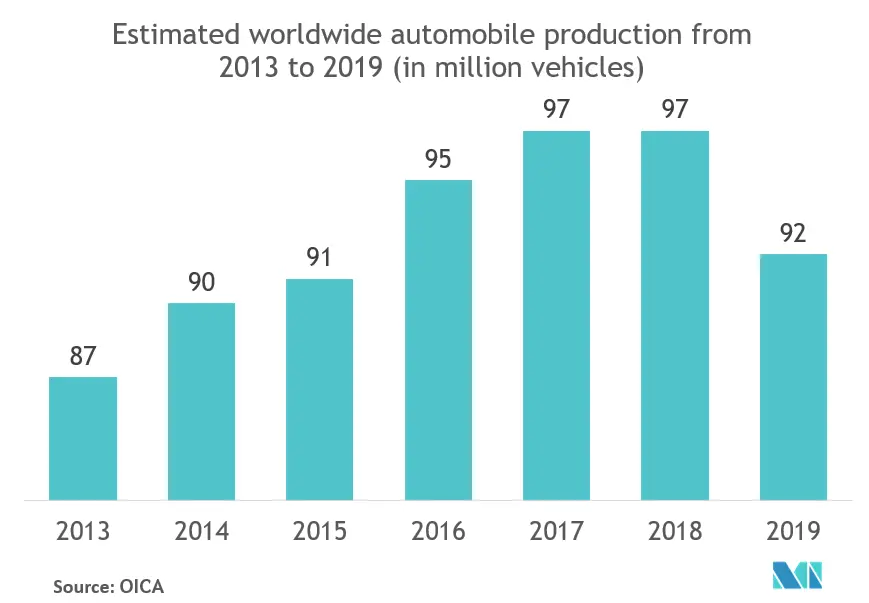Market Trends of MEMS Accelerometer and Gyroscope Industry
This section covers the major market trends shaping the MEMS Accelerometer & Gyroscope Market according to our research experts:
Automotive is Expected to Hold Significant Share
- The MEMS accelerometer and gyroscope play an essential role in improving the safety features of vehicles. With the evolution of autonomous driving, the demand for these sensors is expected to increase multiple -fold for safety -based applications and create opportunities in the market. In March 2019, the European Commission announced a revision of the General Safety Regulations to make autonomous safety technologies a mandatory requirement for vehicles manufactured in Europe, in a bid to bring down accident levels in the region. Stringent regulations are pushing the automotive vendors to implement the latest MEMS sensor-based systems. This is creating opportunities for the market.
- Further, crash sensing for airbag control is driving the demand for inertial MEMS sensors. Companies, such as Analog Devices, Bosch, and STMicroelectronics, among others, have been instrumental in developing MEMS-based accelerometer sensors specified for a temperature range extending from -40 C to +125 C, which is suitable for enabling passive safety during the crash. Companies, such as STMicroelectronics, offer automotive-grade MEMS sensors, the ASM330LHH, to meet the current sensor demands from modern cars. The sensor integrates a 3 D digital accelerometer, gyroscope, and hardware to address automotive in non -safety applications
- Furthermore, currently, vehicles are usually positioned using GPS/GNSS. However, in practical applications, GNSS satellite signals are not wholly reliable in concentrated urban areas with high buildings and overpasses. Besides, basement parking lots, tunnels, dense trees, and other sheltered environments can reduce positioning accuracy. Therefore to improve the efficiency of navigation, Dead Reckoning navigation becomes necessary. In context to Dead Reckoning navigation, in January 2020, Aceinna launched its OpenRTK330 L at CES 2020, a low -cost, high -performance triple-band RTK/GNSS receiver with built-in triple-redundant inertial sensors. It is designed to replace the expensive RTK/INS systems currently used in autonomous systems
- A player such as Locosys Technology Inc. provides Locosys MC -1612 -DG, a single -band multi-system with an ARM-based processor that supports GPS, GLONASS, Galileo, QZSS, and SBAS. The embedded micro-electro-mechanical systems (MEMS) sensor is equipped with dead -reckoning software and provides a six-axis accelerometer and gyroscope data. The dead -reckoning features to boost accuracy with the software filling the gaps in the GNSS conditions such as urban canyons, tunnels, or parking garages.

North America is Expected to Hold Major Share
- North America accounts for significant market growth due to its various applications in the healthcare, automotive, and defense sectors. With the high use of MEMS sensors in the advanced healthcare equipment such as Bio-MEMS is expected to drive the demand for MEMS sensors in the region. Government entities in the region are also investing extensively in the manufacturing facilities of the MEMS-based microfluidic chips.
- Moreover, according to the National Health Expenditure Accounts (NHEA), the healthcare spending in the United States grew by over 4.6% in 2018 and has reached USD 3.6 trillion or USD 11,172 per person accounting for 17.7% of its GDP indicating investment in addressing these trend and is anticipated to complement the MEMS sensor market demand.
- For instance, in June 2019, NASA invested USD 125,000 as phase-I funding for the project by Techshot to develop in-Space manufacturing of microfluidic chips for use in biological research aboard the International Space Station. Moreover, key MEMS sensor vendors in the region are also adopting product innovation strategies to cater to advanced offerings across the industries.
- Stringent government regulations regarding passenger safety and significantly growing automotive and aerospace industries are driving the MEMS accelerometer and gyroscope market in North America. The emergence of information technology (IT), coupled with the increased usage of IoT across a wide range of manufacturing, industrial, and automotive applications, has added a new dimension to conducting business operations in the region.
- Further, for seizing the growth opportunities, the MEMS manufacturers in the region are actively seeking production expansions. For instance, in December 2019, equipment and process solutions provider - SUSS MicroTec announced to enter a partnership BRIDG to invest in focused production process technologies, advanced system integration, and 200mm MEMS fabrication to advancing next-generation nanoscale technology.

